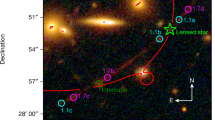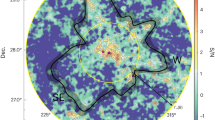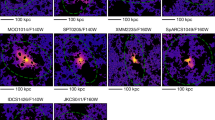Abstract
Identifying galaxy clusters through overdensities of galaxies in photometric surveys is the oldest1,2 and arguably the most economical and mass-sensitive detection method3,4, compared with X-ray5,6,7 and Sunyaev-Zel’dovich effect8 surveys that detect the hot intracluster medium. However, a perennial problem has been the mapping of optical ‘richness’ measurements onto total cluster mass3,9,10,11,12. Emitted at a conformal distance of 14 gigaparsecs, the cosmic microwave background acts as a backlight to all intervening mass in the Universe, and therefore has been gravitationally lensed13,14,15. Experiments such as the Atacama Cosmology Telescope16, South Pole Telescope17,18,19 and the Planck20 satellite have now detected gravitational lensing of the cosmic microwave background and produced large-area maps of the foreground deflecting structures. Here we present a calibration of cluster optical richness at the 10% level by measuring the average cosmic microwave background lensing measured by Planck towards the positions of large numbers of optically selected clusters, detecting the deflection of photons by structures of total mass of order 1014 M ⊙. Although mainly aimed at the study of larger-scale structures, the Planck estimate of the cosmic microwave background lensing field can be used to recover a nearly unbiased lensing signal for stacked clusters on arcminute scales15,21. This approach offers a clean measure of total cluster masses over most of cosmic history, largely independent of baryon physics.
This is a preview of subscription content, access via your institution
Access options
Access Nature and 54 other Nature Portfolio journals
Get Nature+, our best-value online-access subscription
$29.99 / 30 days
cancel any time
Subscribe to this journal
Receive 12 digital issues and online access to articles
$119.00 per year
only $9.92 per issue
Buy this article
- Purchase on Springer Link
- Instant access to full article PDF
Prices may be subject to local taxes which are calculated during checkout



Similar content being viewed by others
Change history
31 January 2018
Owing to a technical error, the ‘Additional information’ section of the originally published PDF version of this Letter incorrectly gave J.A.P. as the corresponding author; it should have read J.E.G. This has now been corrected. The HTML version is correct.
References
Shapley, H. & Ames, A. A study of a cluster of bright spiral nebulae. Harvard College Obs. Circ. 294, 1–8 (1926).
Abell, G. O. The distribution of rich clusters of galaxies. Astrophys. J. Supp. Ser. 3, 211–288 (1958).
Koester, B. P. et al. MaxBCG: A Red-Sequence Galaxy Cluster Finder. Astrophys. J. 660, 221–238 (2007).
Rykoff, E. S. et al. redMaPPer. I. Algorithm and SDSS DR8 catalog. Astrophys. J. 785, 104–137 (2014).
Cavaliere, A. G., Gursky, H. & Tucker, W. H. Extragalactic X-ray sources and associations of galaxies. Nature 231, 437–438 (1971).
Henry, J. P. et al. Detection of X-ray emission from distant clusters of galaxies. Astrophys. J. Lett. 234, L15–L19 (1979).
Ebeling, H., Edge, A. C. & Henry, J. P. MACS: a quest for the most massive galaxy clusters in the Universe. Astrophys. J. 553, 668–676 (2001).
Sunyaev, R. A. & Zeldovich, Ia. B. The observations of relic radiation as a test of the nature of X-ray radiation from the clusters of galaxies. Comm. Astrophys. Space Phys. 4, 173–178 (1972).
Saro, A. et al. Constraints on the richness-mass relation and the optical-SZE positional offset distribution for SZE-selected clusters. Mon. Not. R. Astron. Soc. 454, 2305–2319 (2015).
Andreon, S. Richness-based masses of rich and famous galaxy clusters. Astron. Astrophys. 587, A158–A168 (2016).
Farahi, A., Evrard, A. E., Rozo, E., Rykoff, E. S. & Wechsler, R. H. Galaxy cluster mass estimation from stacked spectroscopic analysis. Mon. Not. R. Astron. Soc. 460, 3900–3912 (2016).
Simet, M. et al. Weak lensing measurement of the mass–richness relation of SDSS redMaPPer clusters. Mon. Not. R. Astron. Soc. 466, 3103–3118 (2017).
Blanchard, A. & Schneider, J. Gravitational lensing effect on the fluctuations of the cosmic background radiation. Astron. Astrophys. 184, 1–6 (1987).
Holder, G. & Kosowsky, A. Gravitational lensing of the microwave background by galaxy clusters. Astrophys. J. 616, 8–15 (2004).
Lewis, A. & Challinor, A. Weak gravitational lensing of the CMB. Phys. Rep. 429, 1–65 (2006).
Das, S. et al. Detection of the power spectrum of cosmic microwave background lensing by the Atacama Cosmology Telescope. Phys. Rev. Lett. 107, 021301 (2011).
van Engelen, A. et al. A measurement of gravitational lensing of the microwave background using South Pole Telescope data. Astrophys. J. 756, 142–162 (2012).
Bleem, L. E. et al. A measurement of the correlation of galaxy surveys with CMB lensing convergence maps from the South Pole Telescope. Astrophys. J. Lett. 753, L9–L15 (2012).
Geach, J. E. et al. A direct measurement of the linear bias of mid-infrared-selected quasars at z≈1 using cosmic microwave background lensing. Astrophys. J. Lett. 776, L41–L47 (2013).
Planck Collaboration. Planck 2015 results XV. Gravitational lensing. Astron. Astrophys. 594, A15–A43 (2016).
Lewis, A. & King, L. Cluster masses from CMB and galaxy weak lensing. Phys. Rev. D 73, 063006 (2006).
Baxter, E. J. et al. A measurement of gravitational lensing of the cosmic microwave background by galaxy clusters using data from the South Pole Telescope. Astrophys. J. 806, 247–262 (2015).
Madhavacheril, M. et al. Evidence of lensing of the cosmic microwave background by dark matter halos. Phys. Rev. Lett. 114, 151302 (2015).
Aihara, H. et al. The eighth data release of the Sloan Digital Sky Survey: first data from SDSS-III. Astrophys. J. Supp. Ser. 193, 29–46 (2011).
Seljak, U. & Zaldarriaga, M. Measuring dark matter power spectrum from the cosmic microwave background. Phys. Rev. Lett. 82, 2636–2639 (1999).
Okamoto, T. & Hu, W. Cosmic microwave background lensing reconstruction on the full sky. Phys. Rev. D 67, 083002 (2003).
Van Engelen, A. et al. CMB lensing power spectrum biases from galaxies and clusters using high-angular resolution temperature maps. Astrophys. J. 786, 13–27 (2014).
Navarro, J. F., Frenk, C. S. & White, S. D. M. The structure of cold dark matter halos. Astrophys. J. 462, 563–575 (1996).
Han, J. et al. Galaxy and mass assembly (GAMA): the halo mass of galaxy groups from maximum-likelihood weak lensing. Mon. Not. R. Astron. Soc. 446, 1356–1379 (2014).
Duffy, A. R., Schaye, J., Kay, S. T. & Dalla Vecchia, C. Dark matter halo concentrations in the Wilkinson Microwave Anisotropy Probe year 5 cosmology. Mon. Not. R. Astron. Soc. 390, L64–L68 (2008).
Bullock, J. S. et al. Profiles of dark haloes: evolution, scatter and environment. Mon. Not. R. Astron. Soc. 321, 559–575 (2001).
Johnston, D. E. et al. Cross-correlation weak lensing of SDSS galaxy clusters II: cluster density profiles and the mass-richness relation. Preprint available at https://arxiv.org/abs/0709.1159 (2007).
Oguri, M. & Hamana, T. Detailed cluster lensing profiles at large radii and the impact on cluster weak lensing studies. Mon. Not. R. Astron. Soc. 414, 1851–1861 (2011).
Oguri, M. & Takada, M. Combining cluster observables and stacked weak lensing to probe dark energy: Self-calibration of systematic uncertainties. Phys. Rev. D 83, 023008 (2011).
Tinker, J. L. et al. The large-scale bias of dark matter halos: numerical calibration and model tests. Astrophys. J. 724, 878–886 (2010).
Planck Collaboration. Planck 2015 results XIII. Cosmological parameters. Astron. Astrophys. 594, A13–A76 (2015).
Foreman-Mackey, D., Hogg, D. W., Lang, D. & Goodman, J. emcee: the MCMC hammer. Publ. Astron. Soc. Pacific 125, 306–312 (2013).
Hu, W. Mapping the dark matter through the cosmic microwave background damping tail. Astrophys. J. 557, L79–L83 (2001).
Hu, W., DeDeo, S. & Vale, C. Cluster mass estimators from CMB temperature and polarization lensing. New J. Phys. 9, 12 (2007).
Maturi, M., Bartelmann, M., Meneghetti, M. & Moscardini, L. Gravitational lensing of the CMB by galaxy clusters. Astron. Astrophys. 436, 37–46 (2005).
Merten, J. et al. CLASH: the concentration-mass relation of galaxy clusters. Astrophys. J. 806, 4–30 (2015).
Acknowledgements
The authors thank G. Holder, A. Lewis, M. Madhavacheril, P. Marshall and E. Rozo for helpful discussions. J.E.G. is supported by a Royal Society University Research Fellowship. J.A.P. is supported by ERC grant no. 670193
Author information
Authors and Affiliations
Contributions
Both authors contributed equally to the analysis and writing of the manuscript.
Corresponding author
Ethics declarations
Competing interests
The authors declare no competing financial interests.
Additional information
Publisher’s note: Springer Nature remains neutral with regard to jurisdictional claims in published maps and institutional affiliations.
A correction to this article is available online at https://doi.org/10.1038/s41550-017-0354-3.
Electronic supplementary material
Supplementary Information
1 Supplementary Figure
Rights and permissions
About this article
Cite this article
Geach, J.E., Peacock, J.A. Cluster richness–mass calibration with cosmic microwave background lensing. Nat Astron 1, 795–799 (2017). https://doi.org/10.1038/s41550-017-0259-1
Received:
Accepted:
Published:
Issue Date:
DOI: https://doi.org/10.1038/s41550-017-0259-1
This article is cited by
-
Forecasts on CMB lensing observations with AliCPT-1
Science China Physics, Mechanics & Astronomy (2022)
-
The detection of the imprint of filaments on cosmic microwave background lensing
Nature Astronomy (2018)
-
The weight of cosmic lenses
Nature Astronomy (2017)



